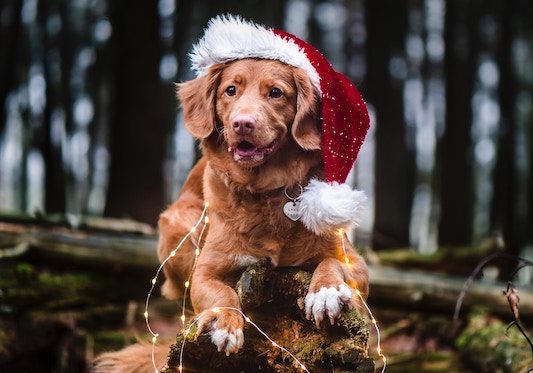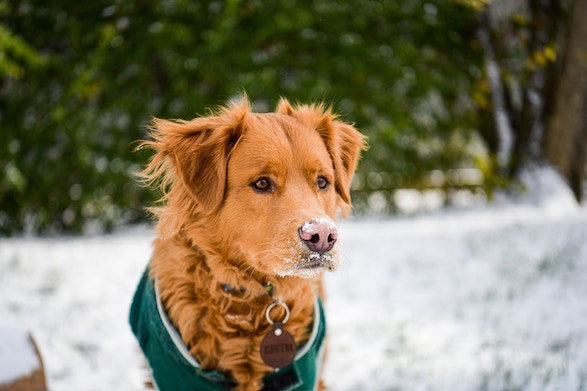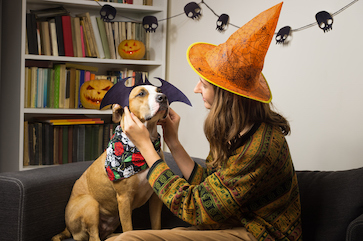Going on walks is often a constant in our daily lives as dog owners. However, a dog that pulls, lays down and will not move, or barks at every little distraction can make us quickly start to dread those times. Even grabbing the leash off the hook can cause your dog to jump all over you or nip at your hands or clothes in excitement or anticipation for their “w-a-l-k.” This time with your pup should be a time for you to bond with little to no stress. Rather than feeling like delaying the inevitable, you should look forward to getting your steps in together and the fresh air! We’ll go into detail on how you can make this happen.
From introducing a new harness to encouraging your pup to be attentive to you while maintaining a heel position, we will cover every detail to get you started.
Step 1: Hand feeding
One of the first steps to set you and your puppy up for the most success is to ensure they will eat while wearing their harness, and outside. Introducing a new piece of equipment in a positive manner is a critical component of any training process. This is especially true for your puppy’s harness, as they will wear it often and for long periods of time. For a harness that will be used for leash walking, we recommend an option where the leash attaches to the chest piece instead of the back. This will make it easier in the training process to discourage your puppy from pulling on the leash while walking. An Easy Walk Harness is a great example of this.
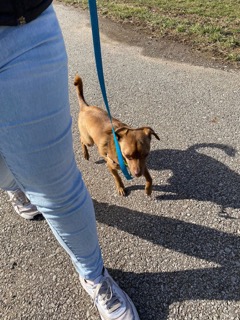
How to use hand feeding to introduce a new harness to your dog
To introduce a new harness effectively, associate your puppy’s meals with putting the harness on, wearing it, and taking it off. Hand feeding is a perfect opportunity to do this, as described in our “Best Ways to Feed Your Puppy” blog.
- Measure out your puppy’s meal into a bowl or treat bag (we like this one!)
- Hold a few pieces between your thumb and forefinger and slide the harness over your puppy’s head
- Feed them
- Continue to feed them every few seconds while you secure and buckle the harness. This will continue to create a positive association with the harness and promote patient behavior while it is being put on.
- Making this a positive experience and reinforcing calm behavior will make it less likely that your puppy jumps on you or bites at the harness in the future.
- Repeat the process as you slowly remove the harness and feed them one last piece of food after you slide it off their head or body
Use food or treats every time you put the harness on your dog until they stand calmly through the entire process without any food.
Step 2: Hand feeding outside
Another important step is making sure your puppy is comfortable taking food outside. It is important that they will reliably eat treats and their regular food when it’s handed to them.
We recommend starting this by just relaxing on your front porch or in your front yard with your puppy wearing a secure collar and leash.
- Measure their food out into a treat bag
- Take a small handful of their food and offer it to them
- Hopefully, they eat it – it’s as simple as that! It will be most convenient to attempt this during your puppy’s normal meal times. If they don’t eat very much, or at all, the first time, bring their food inside and try again for their next meal.
- For the next meal, they should be more hungry. Don’t be afraid to sprinkle in a couple of small treats to entice them!
Once they begin eating reliably outside, you can start to use a hand gesture or verbal command to ask them to sit before receiving food.
In addition or instead of asking for them to sit, you can have them wear their new harness! If you find that your puppy or dog is extremely fearful outside or barks at an intense level at other people or dogs, you should consider reaching out to one of our specialized behavior consultants for help. It’s critical that you seek assistance to treat the underlying behavior before attempting to teach your dog to heel – their safety and comfort are the priority over their obedience.
If your puppy or dog, on the other hand, is eating reliably and attentive despite minor distractions, you are ready for the next step!
Step 3: Walking with a loose leash
Now that you have fitted your puppy with a harness and know they will eat outside, it’s time to start walking! Typically, a heel position is taught with a dog on the left side of the owner’s body. Our guide will reflect this.

- Make sure your puppy is wearing a secure collar, harness, and a leash attached to both for safety.
- Position your puppy so they start by standing on your left side with their nose not crossing the front of your leg. Hold the handle of the leash and additional slack in your right hand (across your body) with a handful of food in your left hand.
- Say “let’s go” to initiate the walk. Make sure the leash is loose at all times!
- Every few seconds, while your puppy remains in heel position, praise your puppy and feed them. Roll a piece from your handful up until it’s between your thumb and forefinger and feed them one piece at a time. Make sure you are offering them the food in line with the seam of your pants to keep your puppy in the heel position.
- When you can walk with 5-10 seconds between treats, keep the food in your treat bag and hold the leash with both hands. Hold the handle of the leash in your right hand and the slack with your left.
- Continue feeding your puppy every 10-15 seconds as they remain beside you. Do this by continuing to walk, dropping the slack with your left hand, and using it to grab a piece of food from your bag, and feed it to your puppy. Once they take it, grab the slack of the leash again so it doesn’t trip you or your puppy.
- In addition to feeding your puppy after a short duration of time, praise and feed them every time they look up and make eye contact with you. We love when our dogs check in with us!
- Over time, continue to increase the time between food or treats. When walking around your neighborhood, you can start to feed based on every driveway you pass, or after every second or third house. Eventually, you can fade food out until you are rewarding your dog for staying beside you during high-level distractions but otherwise occasionally praising them during your walk. High-level distractions might include a squirrel running across the street, another dog passing by, kids riding by on their bikes, etc.
- When you are done walking or want to give your pup a break, say “(your dog’s name), free.” This means they can leave heel position, but they still should not pull you. When you are ready to start walking again, restart from the second step.
Step 4: Generalize!
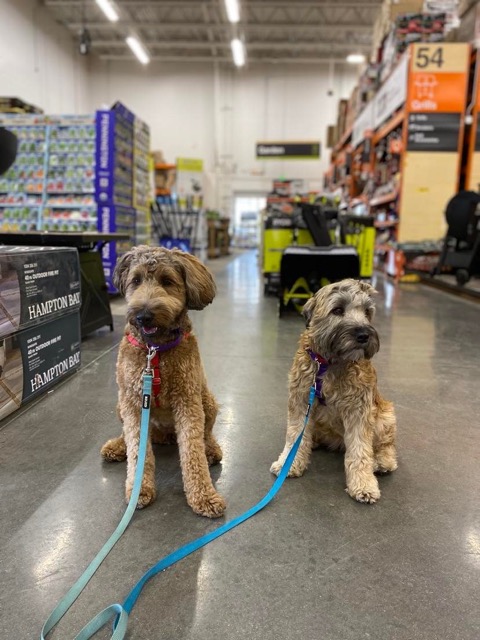
When you feel like you have graduated from the neighborhood, you’re ready for the next level! Gear up and take on the neighborhood during busy times, a local park, playground, or local dog-friendly store! Remember that when more distractions arise, you will need to feed your puppy or dog at a higher rate. This means decreasing the time between treats and feeding faster.
To set your pup up for success, you may need to create distance between the distraction(s) and you and your dog. If they do well and maintain their position, walk closer. If they check in with you less often or pull ahead, walk farther away until they calm back down. Especially if it’s your first time in a new environment, treat it as though it’s your first-time leash walking all over again. Your puppy will need to realize that even though they are surrounded by a lot of exciting new sights and smells, the rules are still the same. Keep these “Heat Safety Tips for Dogs” and “Kansas City Cold Weather Guide” in mind if you are training in moderate to extreme temperatures!
We hope you enjoy bonding with your puppy while training them to walk nicely on a leash! If you find yourself having trouble and looking for assistance, our trainers are just an email or phone call away. In our personalized, in-home programs, we knock out a lot of the leg work for you. Loose leash walking is a common behavior our trainers teach to dogs, and then work one-on-one with the owners to show them how to use and maintain the behavior on their own. Contact us today so we can help you start, or get back to, enjoying those late-afternoon strolls with your pup!

